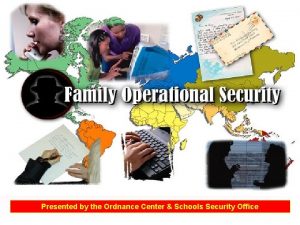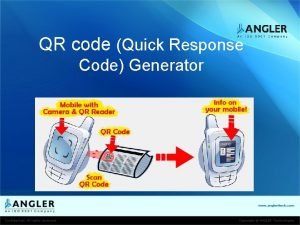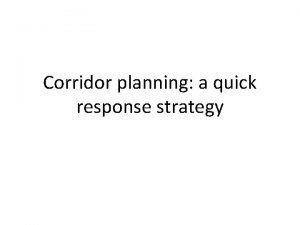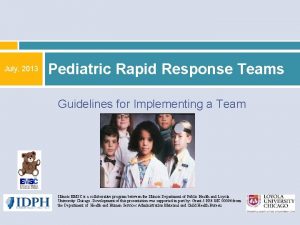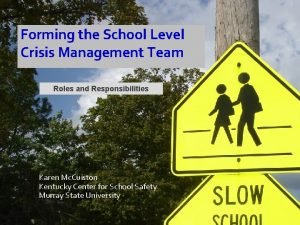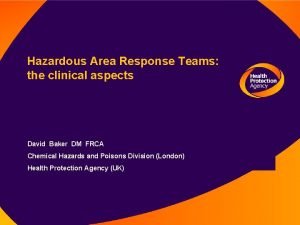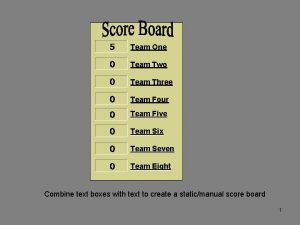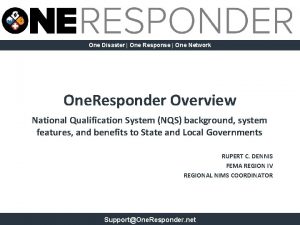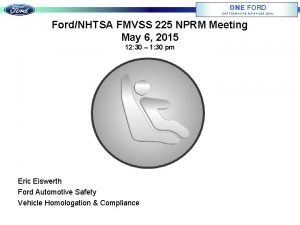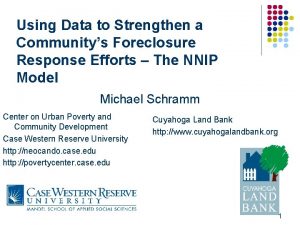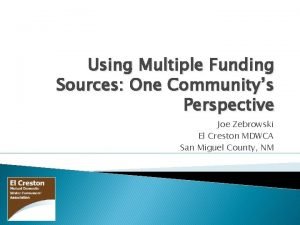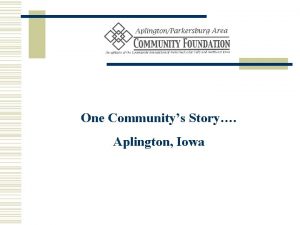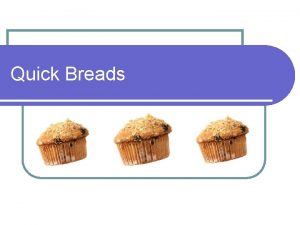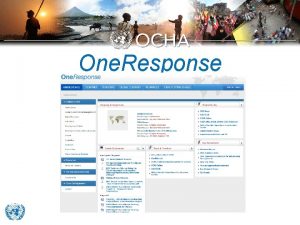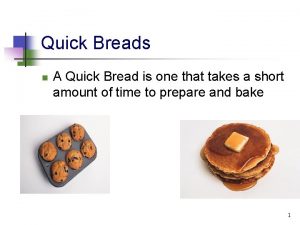Quick Response Team One Communitys Response To The



























- Slides: 27

Quick Response Team One Community’s Response To The Heroin/Opiate Epidemic Colerain Township Department of Public Safety Hamilton County, Ohio

Objectives • Discuss statistical data and scope of epidemic specific to Colerain Township. • Discuss the Quick Response Team (QRT) response model • Discuss the Role of Addiction Services Council of Greater Cincinnati

Objectives • Describe the need for culture change amongst fire, EMS, and law enforcement personnel. • Review the effectiveness of the QRT response model.

Statistical Data: Painting the Picture • • 14 th Largest Community in the State of Ohio 45 Square Miles 60, 000 residents 5 Fire Stations 170 Fire Department Personnel Fire Department Staffing: 33 personnel 54 Law Enforcement Personnel 6 Beat Officers

Statistical Data: Painting the Picture • • • 2011 – 51 Overdoses 2012 – 115 (125% Increase) 2013 – 116 (0. 87% Increase) 2014 – 141 (22% Increase) 2015 – 167 (18% Increase) 2016 – 151* (10% Reduction) • 100 overdoses - September through November 2016 – Carfentinal Total Emergency Medical Responses in 2015 - 7520 Overdose runs = 2. 2% of run volume

2015 Overdose Overview • 26 (16. 6%) incidents of cardiac arrest involved an opiate related overdose. • 66 (39. 5%) of all overdoses occurred in the home. • 100 (59. 8%) of all overdoses were Colerain Township residents.

2015 Overdose Overview • Cardiac Arrests • 26 victims were in cardiac arrest at some point during an overdose event. * *Does not reflect the number of actual deaths

Community Expectations • Public safety for our communities demands a constant review and adjustment: Leaders cannot rest on the success or failure of past responses • Community members believe their government and public safety leaders are working to address the harm associated with this heroin/opioid epidemic • The reality is…. many communities are waiting and watching…afraid to fail or take a risk

QRT Staffing Model • Six firefighter (FF)/medics; each specially trained as a “Tactical Medic” (TACMED) (SWAT, Military and HRT Experience) • Five Police Officers (SWAT, Military, Narcotics Inv. Experience) • FF/medics received additional training in self defense and OC (chemical irritant) deployment; FF/medics carry OC spray • Policy and procedure created to establish team and TACMED FF/medic selection; Differential Patrol Response; TACMED and Response to Aggressive Behavior for FF/Medics

Maintaining HIPAA Compliance • Follow-up is led by police officers and is facilitated by a commitment to investigate the overdose incidents as criminal acts • The officer brings a paramedic and licensed counselor from the Addiction Services Council of Greater Cincinnati • Discretion is used as a means to introducing the counselor


Operational Data • QRT Unit (General Response Model) Operational since July 2015 • Nearly 250 “Overdose Follow-up” investigations to date • QRT responded to more than 1, 050 incidents, to include medic and fire incidents (Experienced “response time” impact) o Worked more than 100 shifts

Overdose Follow-Up Data • The QRT and Addiction Services Council professionals conducted 250 investigations. Almost 80% of the persons have entered treatment – in/outpatient • Conducted “door to door” canvassing of “Working to Save Lives” brochure in Township neighborhoods (5 follow-ups)

Creating the 360 Solution Police officers carrying Nasal Narcan Canvassed “door to door” (Brochure distribution)

Collaborative Assistance • Addiction Services Council of Greater Cincinnati • The QRT effort received $50, 000 Naloxone donation to dispense Narcan during follow-up investigation for patients unable to enter treatment immediately • Ohio Department and Hamilton County Department of Public Health provided Narcan doses for distribution by our QRT • Many others!

Social-Ecological Approach: Working across multiple levels for increased ability to sustain efforts over time and weave into the fabric of the community. 1 6

PROGRESS Precontemplation NO FIRM COMMITMENT TO ACTION Contemplation Preparation Action FIRM COMMITMENT TO ACTION Maintenance RELAPSE

QRT Goal • Move patient towards action • Assist in preparation

The Four Principles of Motivational Interviewing Principle Goal I. Build rapport Express Empathy II. Develop Discrepancy Elicit pros and cons III. Roll with Resistance Respect patient autonomy IV. Support Self-Efficacy Communicate that patient is capable of change 10

Success Requires Culture Change • Why a culture change? • How do we measure culture change?

Success Requires a Culture Change • August 2014 through September 2016: 600+ Recovery Resource Packets Distributed • Shift from approximately 65% to 100%+ in compliance.

Success Requires a Culture Change • 2015: Transport 107 out of 167 overdoses. • Represents a 37% increase from 2014.

Documented Effectiveness and Successes • Cardiac Arrest Data: January 2015 -June 2015 • Total ODs: 96 • Associated Cardiac Arrests: 19 (19. 8%) • Cardiac Arrest Data: July 2015 -December 2015 • Total ODs: 71 • Associated Cardiac Arrests: 7 (9. 8%)

Documented Effectiveness and Successes • Number of responses: January – June 2015 • 96 • Associated Cardiac Arrests: 19 • Number of responses: January – June 2016 • 67 • Associated Cardiac Arrests: 6

Moving Forward • What are next steps?

• Nan Franks, CEO Contact Information • nanf@addictionservicescouncil. org • Shana Merrick, MSW, LSW, CDCA • shanam@addictionservicescouncil. org • Administrator Dan Meloy • dmeloy@colerain. org • Assistant Chief Will Mueller • wmueller@colerain. org

Questions
 One ford
One ford Quick find algorithm
Quick find algorithm 1.7.6 - quick check: frost quick check
1.7.6 - quick check: frost quick check One team, one mission meaning
One team, one mission meaning One team one dream artinya
One team one dream artinya One team one mission meaning
One team one mission meaning Site:slidetodoc.com
Site:slidetodoc.com Quick response code generator
Quick response code generator Quick response strategy
Quick response strategy Bureaucratic bypass syndrome
Bureaucratic bypass syndrome Team spirit becomes team infatuation
Team spirit becomes team infatuation The white team cheers for the blue team, just like
The white team cheers for the blue team, just like One god one empire one emperor
One god one empire one emperor One one one little puppy run
One one one little puppy run One king one law one faith
One king one law one faith One god one empire one emperor
One god one empire one emperor See one do one teach one
See one do one teach one One price policy
One price policy One face one voice one habit and two persons
One face one voice one habit and two persons See one do one teach one
See one do one teach one One vision one identity one community
One vision one identity one community Asean one vision one identity one community
Asean one vision one identity one community Surge and rapid response team salary
Surge and rapid response team salary Pediatric rapid response team
Pediatric rapid response team Crisis management team roles
Crisis management team roles Singcert
Singcert Hazardous area response teams
Hazardous area response teams Total physical response method
Total physical response method



